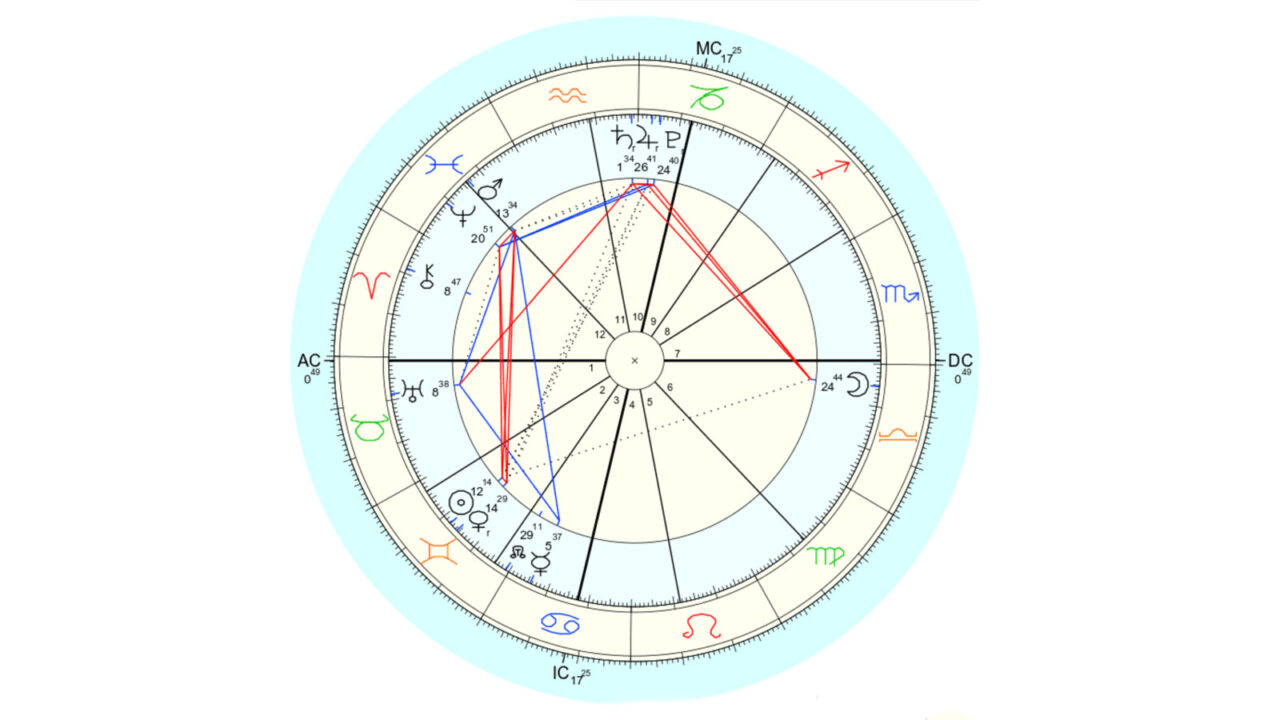What are aspects in the natal chart?
When planets are near the same degree in a horoscope, they are said to be in “aspect” to each other. The mathematical angles between planets tells what kind of aspect it is. Their interpretation depends on which astrological signs the planets are in. Aspects bring out our personal dynamics for better or worse.
For example, if the Sun sits at 6° Taurus in a natal chart it will have an aspect with any planet that is 6° in another sign. The signs will tell what type of relationship the two planets have, easy or difficult. Difficult aspects are referred to as “hard” aspects and easy aspects are referred to as “soft”.
Orbs are how close in degree one planet is aspected to another. The tighter the orb (or the closeness of the degree number) the stronger the energy. For example, if the Sun is at 6° Taurus and Mars is at 7° Taurus, the planets are in a conjunction aspect with a 1° orb. One degree is a “tight” orb. If Mars sits at 13° Taurus instead of 6°, there is a conjunction but with a much “looser” orb.
The amount of orb to use in aspects is often down to the planets in question and the opinion of the astrologer. For the major planets in our solar system orbs up to 10° apart can be used.
The Major Aspects
Conjunction – 0° (same sign – hard or soft aspect)
The conjunction tends to be a harmonious aspect. Its quality depends greatly on the planets involved, as well as on how close the aspect is. For example, a conjunction between the Sun and Mercury is generally regarded as harmonious. If, however, the distance between them is less than a few degrees, Mercury is said to be “burnt” or “in combustion”, with corresponding results. In general, the conjunction shows an immediate connection which usually works in one way or another.
Sextile – 60° (2 signs apart – soft aspect)
The sextile tends to have a harmonious effect, depending of course on the planets involved. The planets can communicate with each other easily.
Square – 90° (3 signs apart – hard aspect)
The square is regarded as a disharmonious aspect, the planets involved seem to be “blocked”. There is dynamic tension and a problem that needs to be solved. Often this takes the form of desires and needs which are mutually exclusive. The problems that arise from the square keep on turning up, like a bad penny. The difficulty lies in trying to reconcile two forces that are trying to move in completely different directions.
Trine – 120° (4 signs apart – soft aspect)
The trine is a harmonious aspect, the planets involved work together in a complementary fashion, enriching one another. Trines show where our natural talents lie, whether we actually make use of them or not is up to us. Trines can make things so easy for us that we can end up lazy in those areas.
Opposition – 180° (6 signs apart – hard aspect)
Although the opposition is generally regarded as “disharmonious” or dynamic, it often has quite a motivating and energizing effect. Here too, the quality of the aspect depends on the planets involved, and on what one makes of it. On the whole, an opposition between two planets creates tension between them, often with positive results.
Minor Aspects
Besides the major aspects mentioned above, there are also quite a number of “minor aspects”. Most of these are subdivisions of the major aspects. The minor aspects add depth and detail to the general picture. The orbs permitted for the minor aspects are much smaller than those used for the major aspects.
The most common minor aspects are:
Semisquare or Octile – 45°, disharmonious
Sesquisquare or Trioctile – 135°, disharmonious
Semisextile – 30°, neutral (1 sign apart)
Quincunx or Inconjunct – 150°, neutral (5 signs apart)
Quintile – 72°, harmonious
Biquintile – 144°, harmonious
Multi-Planet Aspect Combinations (when 3 or more planets are in orb to each other):
T-Square – formed by two squares and one opposition (3 planets in conflict with each other)
Grand Cross – formed by four squares and two oppositions (4 planets in conflict with each other)
Grand Trine – formed by 3 planets all 120° apart from each other (3 planets in harmony, easy flow of energies)
Yod or the Finger of God -formed two planets in sextile and both quincunx to a third (3 planets – disharmonious) the planet that is quincunx is a release point for the energy of the others in sextile.
